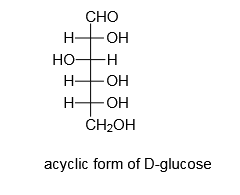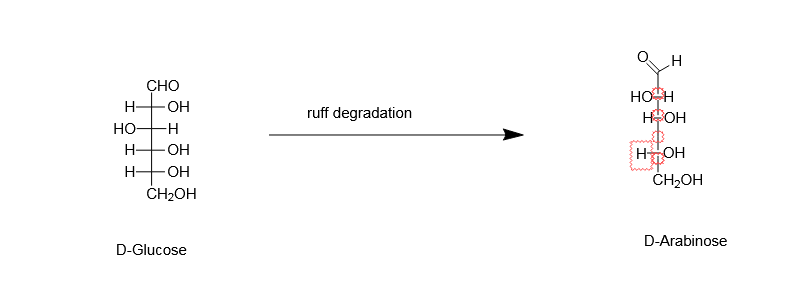Answer
37.2k+ views
Hint: Ruff degradation is a synthetic method to shorten the carbon-chain. It was first studied by Otto Ruff on glucose molecules.
Complete solution:
If we will add an aldehydic group to an acyclic form of monosaccharide, the resulting monosaccharide will be an aldose.

Ruff degradation will shorten the above chain by removing one carbon atom.

The overall conversion mechanism can be stated as follows-
The terminal aldehydic group is made to undergo selective oxidation, by using bromine water, and then it is converted to gluconate ion. In the next step, $Fe(OAc)3$ with 30% of $H2O2$ is added. This will result in the formation of $CO2$ along with a stereo selective compound from COO- ion. And in the downside, $ - CH2OH$will get converted to $ - CHO$ group. This conversion is achieved by the reduction of iron $Fe$ from its +3 state to +2 state. In this way, we get the product, D-Arabinose.

So, the correct option is D.
Note:
Ruff degradation has been named after its discoverer, Otto Ruff.
Alcohol dehydrogenase (ADH) is the enzyme that can break down alcohol into acetaldehyde. This enzyme can be found in the liver cells.
Arabinose acts as an inhibitor of enzyme Sucrase. This enzyme is present in the small intestine and helps to break down sucrose into fructose and glucose. Because of this ability, it is commercialized as a sweetener.
Arabinose is also used as a reversible switch for protein expression in E.coli
Complete solution:
If we will add an aldehydic group to an acyclic form of monosaccharide, the resulting monosaccharide will be an aldose.

Ruff degradation will shorten the above chain by removing one carbon atom.

The overall conversion mechanism can be stated as follows-
The terminal aldehydic group is made to undergo selective oxidation, by using bromine water, and then it is converted to gluconate ion. In the next step, $Fe(OAc)3$ with 30% of $H2O2$ is added. This will result in the formation of $CO2$ along with a stereo selective compound from COO- ion. And in the downside, $ - CH2OH$will get converted to $ - CHO$ group. This conversion is achieved by the reduction of iron $Fe$ from its +3 state to +2 state. In this way, we get the product, D-Arabinose.

So, the correct option is D.
Note:
Ruff degradation has been named after its discoverer, Otto Ruff.
Alcohol dehydrogenase (ADH) is the enzyme that can break down alcohol into acetaldehyde. This enzyme can be found in the liver cells.
Arabinose acts as an inhibitor of enzyme Sucrase. This enzyme is present in the small intestine and helps to break down sucrose into fructose and glucose. Because of this ability, it is commercialized as a sweetener.
Arabinose is also used as a reversible switch for protein expression in E.coli
Recently Updated Pages
If a wire of resistance R is stretched to double of class 12 physics JEE_Main

The path difference between two waves for constructive class 11 physics JEE_MAIN

What is the difference between solvation and hydra class 11 chemistry JEE_Main

IfFxdfrac1x2intlimits4xleft 4t22Ft rightdt then F4-class-12-maths-JEE_Main

Sodium chloride is purified by passing hydrogen chloride class 11 chemistry JEE_Main

Consider the following oxyanions PO43P2O62SO42MnO4CrO4S2O52S2O72 class 11 chemistry JEE_Main

Other Pages
Formula for number of images formed by two plane mirrors class 12 physics JEE_Main

Differentiate between homogeneous and heterogeneous class 12 chemistry JEE_Main

Explain the construction and working of a GeigerMuller class 12 physics JEE_Main

A currentcarrying coil is placed in a magnetic field class 12 physics JEE_Main

In the given circuit the current through the 5mH inductor class 12 physics JEE_Main

In a family each daughter has the same number of brothers class 10 maths JEE_Main



